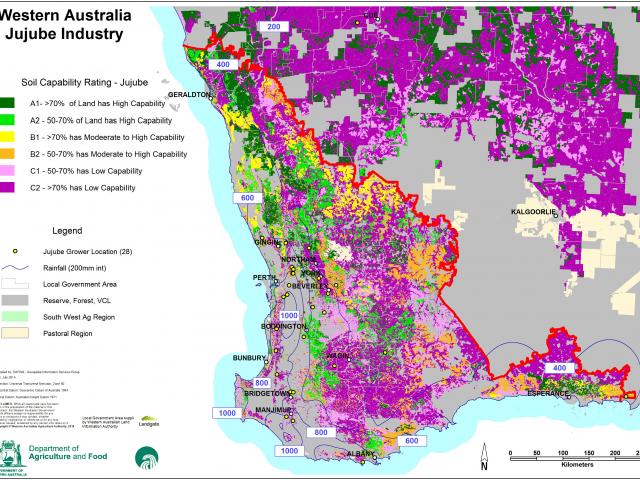Establishing a jujube orchard
Climate and soils
Jujube trees have a lower water requirement and higher salt tolerance than most fruit crops. Under natural conditions the tree forms a deep and substantial taproot making it drought tolerant. Jujube trees grow best in climates with a long, hot, dry summer after adequate rain early in the season and cool temperatures during its dormancy.
In Western Australia, jujubes are grown in areas with around 200–1000mm annual rainfall.
Studies from China suggest the chilling requirement depends on the cultivar and can range from 775 to 1737 hours at less than 7.2°C. However, areas in WA where jujubes are grown are somewhat lower than this range, yet flowering and fruit set occurs. There is perhaps more to be understood regarding the true chilling requirement for Chinese jujubes under Australian climatic conditions but low to medium chill varieties would be best suited to WA.
Fruit set requires average daily temperatures above 20ºC. Fruit development requires average daily temperatures over 24–25ºC.
Jujubes grow well on a variety of soils. The tree prefers sandy loams or lighter soils but will grow on heavier clays. The jujube tree can tolerate saline, alkaline or slightly acidic soils but grows best in soil with pH 4.5–8.4.
| Condition | Value |
|---|---|
| Annual average temperature (ºC) | 5.5–22 |
| Average temperature of flower season (ºC) | ≥22–24 |
| Minimum temperature (ºC) | ≥ minus 38.2 |
| Frost-free period (days) | ≥100 |
| Annual rainfall (mm) | 87–2000 |
| Annual sunshine (hours) | ≥1100 |
| Soil depth (cm) | ≥30 |
| Soil pH | 4.5–8.4 |
| Soil NaCl (%) | ≤0.15 |
| Soil Na2CO3 (%) | ≤0.3 |
| Soil Na2SO4 (%) | ≤0.5 |
Salt tolerance
Jujubes are known for their salt tolerance but this varies between cultivars. In Western Australia trees have grown successfully using irrigation water with an electrical conductivity of 320mS/m (1800ppm).
Varieties
There are close to 1000 jujube cultivars recorded in China and the number will increase continuously as new cultivars are developed and local traditional cultivars identified.
There is enormous variation among cultivars which can be classified into five groups based on the use of the fruit: fresh; dried; candied; multipurpose and ornamental.
In WA around 15 recognised varieties are grown including Li, Chico, Don Polenski, GA866, Suimen, Thornless, Lang, Silverhill, Sherwood, Shanxi-Li, Redlands, Admiral Wilkes and Si-Hong. The varieties Chico and Li are most favoured fruit in the current local market.
Orchard set up
Conventional jujube orchards are planted at spacings of 4–5m x 5–6m. In China, intensive orchards are planted at 2–3m x 3–4m, 1m x 2m in planned intensive planting, 0.5–0.7m x 1m in super-intensive plantings and protected plantings in greenhouses. In WA the number of trees planted per hectare ranges from around 550 to 1000.
Prior to planting, pits of 0.6–1m cubed are dug at appropriate distances depending on orchard density. The pits are filled with original soil mixed with manure, superphosphate and trace elements. Transplanting trees in the field is most successful just prior to bud burst.
Jujube trees can be damaged by winds so windbreaks are advised if the site is susceptible to strong prevailing winds. Netting is recommended to protect jujube orchards from birds, rabbits and kangaroos.
Economic analysis estimates that establishment costs for a one hectare netted jujube orchard with drip irrigation (including pump, main and sub lines and installation) is over $110 000. Most of the development costs are for trellising and netting and the cost of plants. In the current market it is estimated that it would take eight years until cash flow becomes positive. For more information see the attached document 'Jujube development budget and market analysis'.

